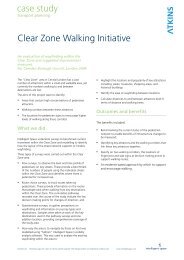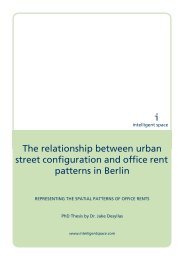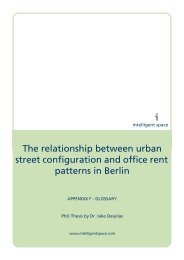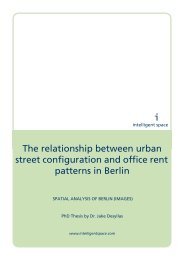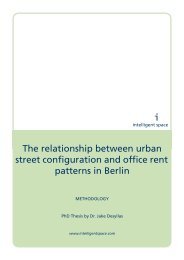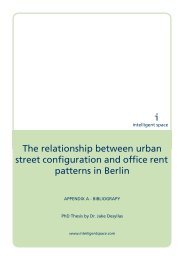Notting Hill Carnival Strategic Review - Intelligent Space
Notting Hill Carnival Strategic Review - Intelligent Space
Notting Hill Carnival Strategic Review - Intelligent Space
Create successful ePaper yourself
Turn your PDF publications into a flip-book with our unique Google optimized e-Paper software.
Conclusions<br />
Bayswater Road and/or into the Hyde Park. By comparison, the scope for extending the<br />
Horseshoe route is limited. Because of the enclosing effect of the route, the only viable<br />
options for extension (without going through a network of side streets) appeared to be either<br />
along Kensal Road/Elkstone Road or on section of Harrow Road. This means that, at best,<br />
the capacity of the Horseshoe route could only be restored to a level similar to that of the<br />
existing route.<br />
2.80 As can be expected from a complex event such as the <strong>Notting</strong> <strong>Hill</strong> <strong>Carnival</strong>, the <strong>Carnival</strong> Public<br />
Safety Project identified some benefits as well as pitfalls in all of the proposed alternative<br />
routes, none of which were able to provide an ‘easy fix’ for enhanced crowd safety. On the<br />
basis of all aspects of the assessment, and weighing up and comparing the pros and cons of<br />
each, the Project listed proposed routes in order of preference from the perspective of crowd<br />
safety thus:<br />
(1) Chair<br />
(2) Reverse Park<br />
(3) West-East Ell (considered as the option for judging on Bishops Bridge Road); and<br />
(4) East-West Ell (if the judging point is moved and the length is reconsidered).<br />
2.81 The Merging Horseshoe and Horseshoe routes were not recommended for further planning<br />
consideration by the Project. This was of particular concern to <strong>Carnival</strong> participants (for whom<br />
the Merging Horseshoe had been the preferred route) and WCC (who had put forward the<br />
Horseshoe route). Indeed, WCC made clear its intention to challenge any route, which<br />
brought the <strong>Carnival</strong> into the central London area.<br />
Determining the “<strong>Carnival</strong> Route of the Future” - The Interim Route<br />
2.82 Taking into consideration the findings of the <strong>Carnival</strong> Public Safety Project, as well as the<br />
logistical questions posed by the possible relocation of the changing areas of some<br />
masquerade bands, the Reverse Park route was perceived by the <strong>Carnival</strong> <strong>Review</strong> Group as a<br />
possible ''<strong>Carnival</strong> Route of the Future''. Members acknowledged the potential of the Reverse<br />
Park to elevate the status of the <strong>Notting</strong> <strong>Hill</strong> <strong>Carnival</strong> by attracting new audiences and<br />
providing enhanced viewing and performance areas. Operationally, the emergency services,<br />
the Metropolitan Police Service and the transport agencies endorsed the route. The<br />
masquerade bands acknowledged that whilst the Reverse Park was not their preferred option,<br />
it did represent 80 per cent of the Merging Horseshoe route and was ‘fundamentally good’.<br />
According to the risk assessment produced under the <strong>Carnival</strong> Public Safety Project, the<br />
Reverse Park was one of the better options from a crowd safety standpoint.<br />
2.83 Based on the risk assessment undertaken by the <strong>Carnival</strong> Public Safety Project, the Horseshoe<br />
route, which had been proposed by WCC and supported by RBKC, was one of the least<br />
desirable route options from a crowd safety perspective and contained the same risk elements<br />
as the current route. It offered a considerably reduced <strong>Carnival</strong> area, thus significantly<br />
exacerbating the dangers of crowd and route congestion. The local authorities argued that<br />
whilst it was important to identify a new route, this was not in itself enough to ensure a safe<br />
event. The problems of crowd safety at the <strong>Carnival</strong> arose from the fact that the streets of<br />
<strong>Notting</strong> <strong>Hill</strong> were not designed for such an event. In the run up to the <strong>Carnival</strong> in 2002, WCC<br />
and RBKC put forward a further option – the introduction of an ‘interim’ route for 2002. The<br />
route proposed was the horseshoe route with a number of significant changes: the direction<br />
107



